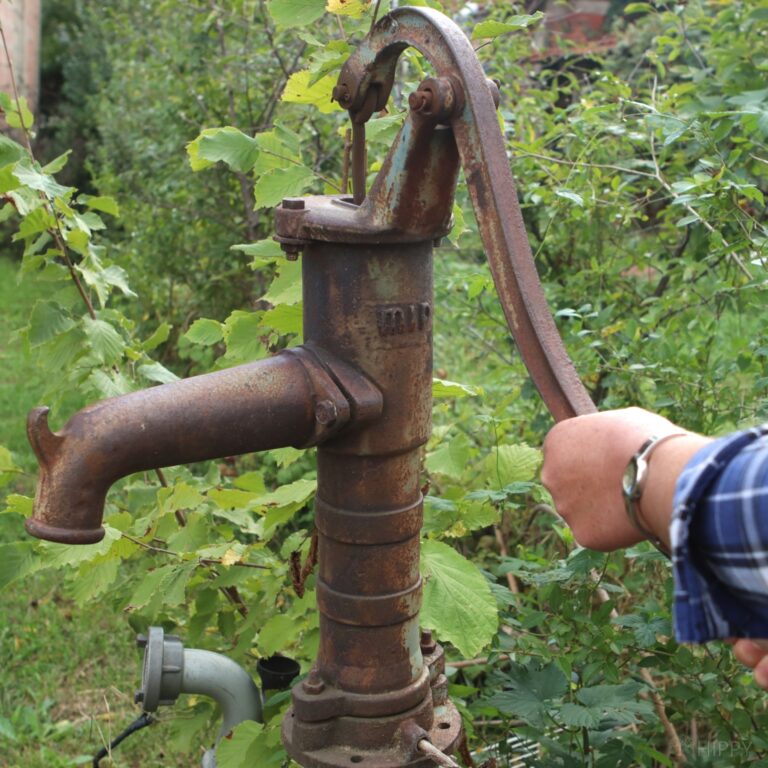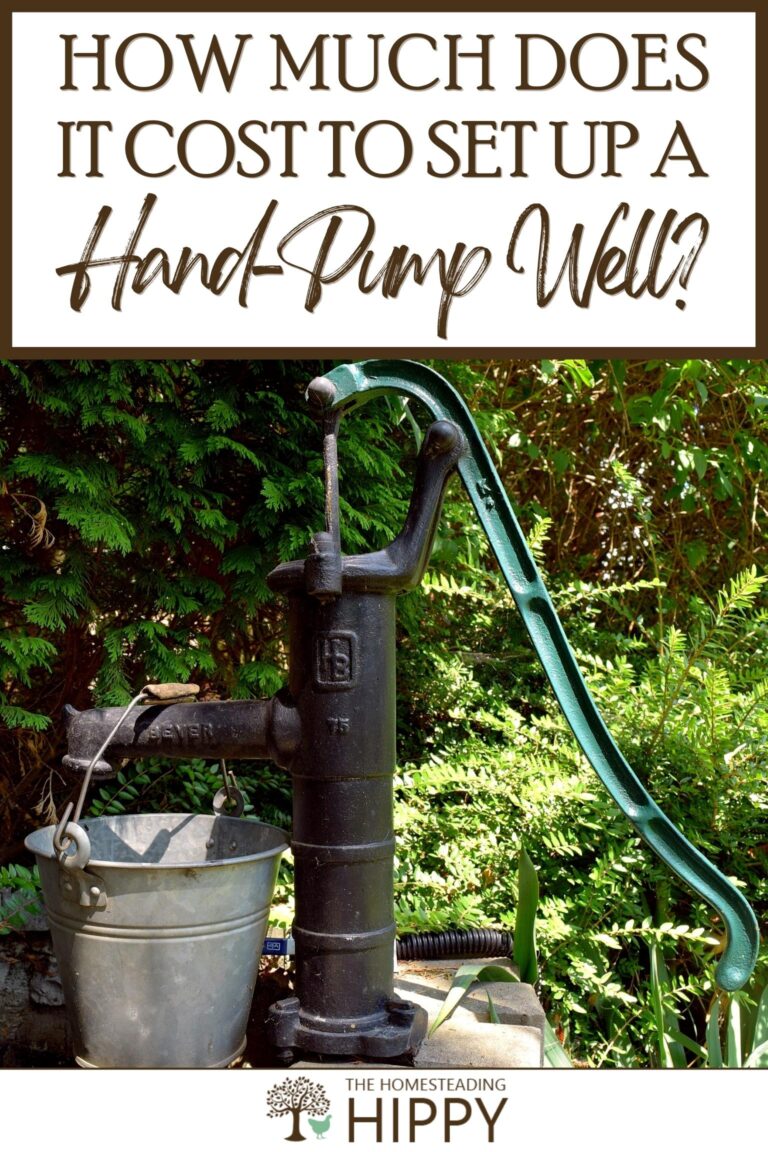For those homesteaders who want to be totally self-sufficient, a well is a must. But virtually every well these days requires a pump that runs on electricity.

It is possible to generate your own off-grid electricity to keep the pump working, but these added infrastructure costs might be a bit much for some to handle.
One alternative that has been proven through centuries of use is the hand pump. A little muscle power is all that is needed to bring your water right to the tap.
So, how much does it cost to set up a hand pump well?
A hand pump well can cost as little as $50 to over $2,000 depending on various factors. Well depth, the difficulty of drilling, type of hand pump, and professional installation all increase costs.
A hand pump well might be easily and cheaply had by DIY modifying an existing sand-point well or you may need to shell out the big bucks to have professional installers put one in for you.
There are many variables, and you’ll need to figure them out so you can budget accordingly. We’ll talk about them below.
What are the Total Costs of a Professionally Installed Hand Pump Well?
You can expect to pay anywhere from $500 to $2,000 for professional installation of a hand pump well of modest depth, depending on terrain and other factors. If you need a deep well it will cost significantly more, sometimes a lot more.
A Hand Pump Can be Added to Most Wells
It should be pointed out first and foremost that a hand pump is not a specific type of well installation; instead, it is exactly what it says it is, a pump. Accordingly, most wells can be fitted with a hand pump used for potable or non-potable water.
If you have an existing well on your property and just want the functionality of a hand pump, you can look into changing out your existing electric pump for a manually operated one.
In-Home Installations Usually Cost More Than Outside Installations
The big thing that will influence the cost of your hand pump well besides the depth and complexity of the well itself is whether it will be installed indoors or outdoors.
Indoor hand pump wells that supply a kitchen or mudroom sink are much less common these days, but allow you to rely on your pump like you would a faucet. These are obviously easiest to install when a house is being built, but can be retrofitted.
There are some obvious benefits to having an indoor hand pump well…
First, you don’t have to go outside to get your water, which might be very convenient in bad weather.
Secondly, an indoor installation might be able to be plumbed into your home’s existing water system, so you can use the hand pump well as a backup in case of power outages or other water disruptions.
An outdoor installation is exactly what it sounds like: the pump is located outside, either next to the house or directly over the well, and water is drawn from there and brought by hand or piped inside with a hose.
This is generally the less expensive option and does not require you to build or modify your home in any way.
The Pump Itself Greatly Influences Price
The construction and materials of the hand pump itself will significantly influence the price of the installation.
Not all hand pumps are created equal, and there is a wide range of prices for the devices themselves depending on whether you want something that is plastic, utilitarian and light duty or a beautiful, bespoke metal model that would not look out of place in the nicest kitchen.
Other feature sets independent of material affect price also.
The least expensive hand pumps generally have to be placed directly over the well, and require some strength and coordination to operate.
A more expensive model might be easier to use, drawing more water with much less effort, or even have a built-in holding tank so water can be drawn and stored for later use.
As with anything, you generally get what you pay for. Cheaper models are more likely to break and will need to be replaced more often.
More expensive models, while not invulnerable to wear and tear, should last much longer.
If looks aren’t a concern you can always save money in that department. On the other hand, a “farm grade” hand pump sticking up over your kitchen sink is an eyesore.
Deep Well Hand Pumps Cost Significantly More
For truly deep wells, a hand pump might still be viable, but you’ll probably need a special model. These pumps, as a rule, are more expensive, but there are a few reasons for this.
First, they must be built stronger to withstand the increased forces needed to raise water from greater depths.
Second, they invariably need a longer stroke to reach the water, and third, they often have to be placed immediately next to the well instead of inside your home or away from the well site.
As with all such special equipment, they cost more.
Deeper Wells Always Cost More, Too
Speaking of deep wells, if you are drilling your well, you will also spend a bundle if you need a deep one.
Not only does the driller charge more for time and labor, but you also have to factor in the cost materials in the form of the casing, pipe, and other components needed to reach the water.
If you live in an area with a lot of rocky soil, this can also add to the cost as a rotary drill is needed instead of a percussion one, and these are both slower and more expensive.
You Can Save Money Installing it Yourself
If you are handy, and if your target water source is shallow enough (less than 50 feet), you might be able to install the hand pump well yourself from front to back. This obviously saves a lot of money on labor costs, but it isn’t for everyone.
It is possible to install a deeper well yourself, to a point, but you’ll need heavy equipment, know-how, and good guidance on locating the shaft. It is easy to mess things up and get in over your head.
If you aren’t confident in your abilities it is probably best to hire a professional. And, of course, professional installation will add cost in direct proportion to the time and complexity of the job.
Think Twice Before Relying on Shallow Wells for Drinking Water
One last thing: think twice before you decide to drink untreated water from a shallow well.
Such wells are highly vulnerable to contamination as a rule, and while you might get away with it for a while, it is only a matter of time before something gets into the water.
If you do go the shallow well route, at least have the water regularly tested and treated as needed. It is a lot cheaper than getting sick.

Tom has built and remodeled homes, generated his own electricity, grown his own food and more, all in quest of remaining as independent of society as possible. Now he shares his experiences and hard-earned lessons with readers around the country.
Find out more about the team here.

I have an electric pump on a well approximately 110 foot, in a well house with fairly easy to remove ceiling/roof access . What style, make would you recommend for this application, will probably run it to storage tanks
That a 110 foot in depth.